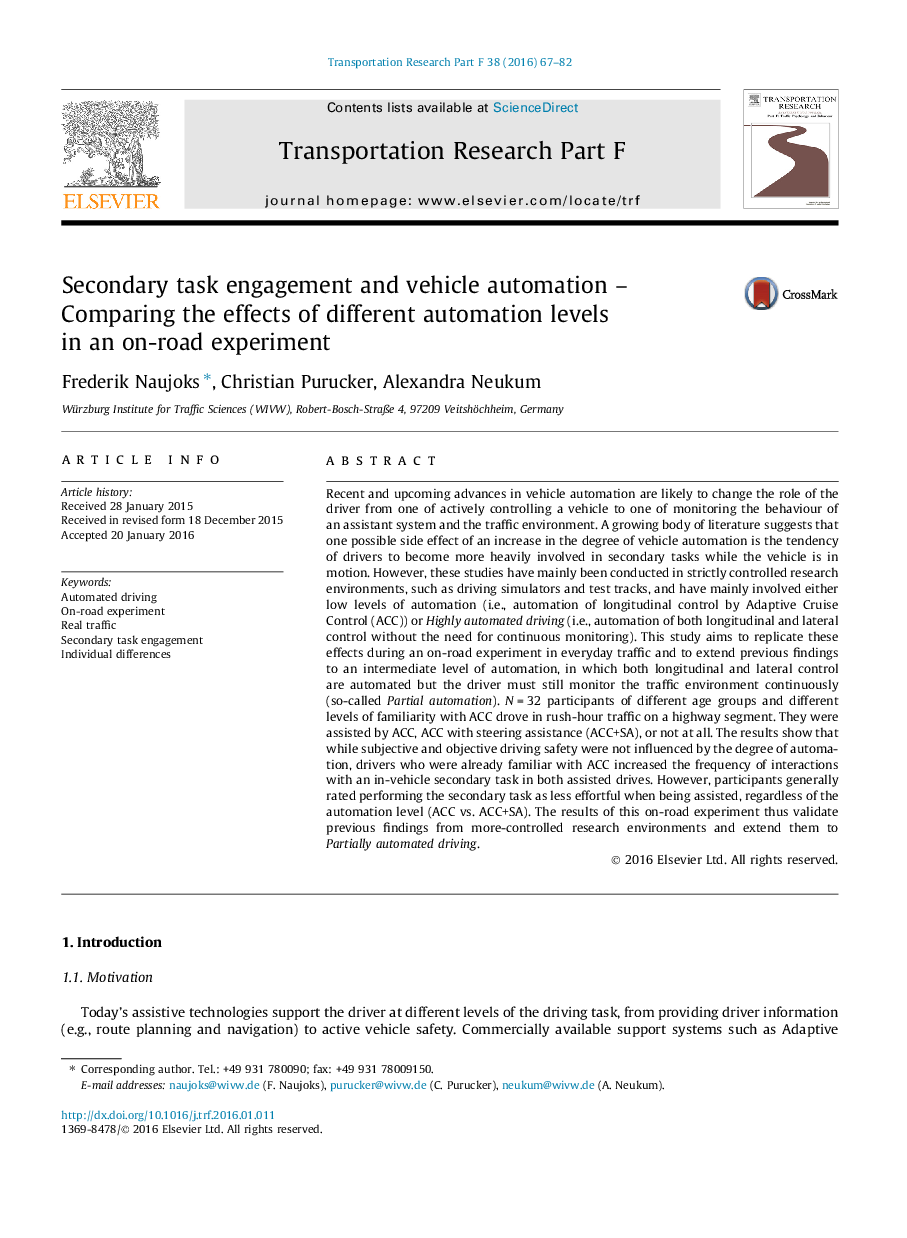| کد مقاله | کد نشریه | سال انتشار | مقاله انگلیسی | نسخه تمام متن |
|---|---|---|---|---|
| 7258141 | 1472445 | 2016 | 16 صفحه PDF | دانلود رایگان |
عنوان انگلیسی مقاله ISI
Secondary task engagement and vehicle automation - Comparing the effects of different automation levels in an on-road experiment
ترجمه فارسی عنوان
تعامل کار دوم و اتوماسیون خودرو - مقایسه اثرات سطوح مختلف اتوماسیون در یک آزمایش جاده ای
دانلود مقاله + سفارش ترجمه
دانلود مقاله ISI انگلیسی
رایگان برای ایرانیان
کلمات کلیدی
رانندگی خودکار آزمایش جاده ای ترافیک واقعی، مشارکت وظیفه ثانوی، تفاوتهای فردی،
موضوعات مرتبط
علوم انسانی و اجتماعی
روانشناسی
روان شناسی کاربردی
چکیده انگلیسی
Recent and upcoming advances in vehicle automation are likely to change the role of the driver from one of actively controlling a vehicle to one of monitoring the behaviour of an assistant system and the traffic environment. A growing body of literature suggests that one possible side effect of an increase in the degree of vehicle automation is the tendency of drivers to become more heavily involved in secondary tasks while the vehicle is in motion. However, these studies have mainly been conducted in strictly controlled research environments, such as driving simulators and test tracks, and have mainly involved either low levels of automation (i.e., automation of longitudinal control by Adaptive Cruise Control (ACC)) or Highly automated driving (i.e., automation of both longitudinal and lateral control without the need for continuous monitoring). This study aims to replicate these effects during an on-road experiment in everyday traffic and to extend previous findings to an intermediate level of automation, in which both longitudinal and lateral control are automated but the driver must still monitor the traffic environment continuously (so-called Partial automation). NÂ =Â 32 participants of different age groups and different levels of familiarity with ACC drove in rush-hour traffic on a highway segment. They were assisted by ACC, ACC with steering assistance (ACC+SA), or not at all. The results show that while subjective and objective driving safety were not influenced by the degree of automation, drivers who were already familiar with ACC increased the frequency of interactions with an in-vehicle secondary task in both assisted drives. However, participants generally rated performing the secondary task as less effortful when being assisted, regardless of the automation level (ACC vs. ACC+SA). The results of this on-road experiment thus validate previous findings from more-controlled research environments and extend them to Partially automated driving.
ناشر
Database: Elsevier - ScienceDirect (ساینس دایرکت)
Journal: Transportation Research Part F: Traffic Psychology and Behaviour - Volume 38, April 2016, Pages 67-82
Journal: Transportation Research Part F: Traffic Psychology and Behaviour - Volume 38, April 2016, Pages 67-82
نویسندگان
Frederik Naujoks, Christian Purucker, Alexandra Neukum,
